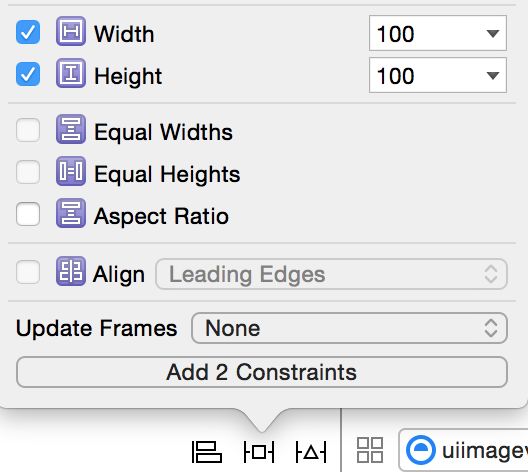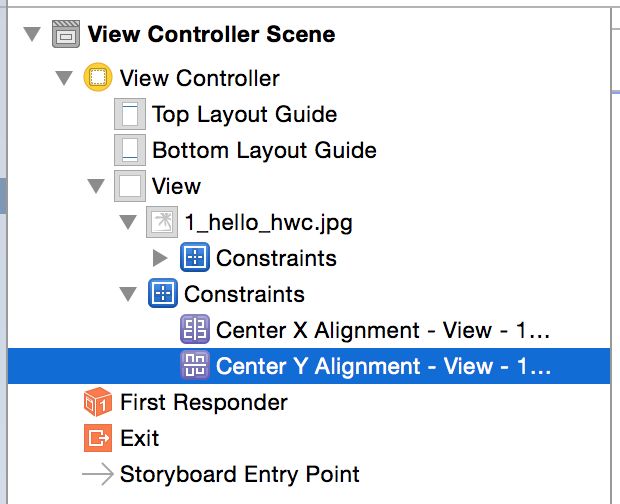iOS Core Animation详解(四)AutoLayout中的动画
原创blog,转载请注明出处
blog.csdn.net/hello_hwc
欢迎关注我的iOS SDK详解专栏
http://blog.csdn.net/column/details/huangwenchen-ios-sdk.html
前言:AutoLayout定义了View的位置,也就是说,在Auto Layout的工程里,如果不修改约束本身,在视图重新绘制的时候,还会回到最开始的位置。AutoLayout中的动画与视图的位置和大小有关。
先看看效果
实现过程
在Storyboard上拖拽一个UIImageview。设置约束为:水平垂直正中心,大小很定100*100


拖拽Imageview以及Constraint为Outlet
注意拖拽Y相关的约束,也就是这个
@IBOutlet weak var imageview: UIImageView!
@IBOutlet weak var yConstraints: NSLayoutConstraint!在viewDidload中设置imageview的初始状态
yConstraints.constant = yConstraints.constant - CGRectGetHeight(UIScreen.mainScreen().bounds)/2
self.imageview.alpha = 0.0;
self.imageview.transform = CGAffineTransformMakeScale(0.1, 0.1)
self.view.layoutIfNeeded();ViewWillAppear中创建动画
yConstraints.constant = yConstraints.constant + CGRectGetHeight(UIScreen.mainScreen().bounds)/2
UIView.animateWithDuration(1.0, animations: { () -> Void in
self.imageview.alpha = 1.0
self.imageview.transform = CGAffineTransformIdentity
self.view.layoutIfNeeded()
})原理
原理比较简单,就是利用修改约束NSLayoutConstraint中的属性constant,然后调用
layoutIfNeeded来实现动画。注意,属性multiplier目前(iOS 8.4)还是只读的,不能修改。但是可以通过关系view1.property = view2.property * multiplier + constant进行转换。
纯代码的AutoLayout动画
上述动画用纯代码实现
class ViewController: UIViewController {
var imageview:UIImageView?
weak var yConstraint:NSLayoutConstraint?
override func viewDidLoad() {
super.viewDidLoad()
//添加Imageview
let image = UIImage(named: "1_hello_hwc.jpg")
imageview = UIImageView(image: image)
self.imageview?.setTranslatesAutoresizingMaskIntoConstraints(false)
self.view.addSubview(self.imageview!)
//创建约束,定义最开始的位置
let hC = NSLayoutConstraint(item:self.view, attribute:NSLayoutAttribute.CenterX, relatedBy: NSLayoutRelation.Equal, toItem: self.imageview, attribute: NSLayoutAttribute.CenterX, multiplier: 1.0, constant: 0.0)
let vC = NSLayoutConstraint(item:self.view, attribute:NSLayoutAttribute.CenterY, relatedBy: NSLayoutRelation.Equal, toItem: self.imageview, attribute: NSLayoutAttribute.CenterY, multiplier: 1.0, constant: 0.0)
yConstraint = vC;
yConstraint!.constant = yConstraint!.constant - CGRectGetHeight(UIScreen.mainScreen().bounds)/2
let widthC = NSLayoutConstraint(item:self.imageview!, attribute: NSLayoutAttribute.Width, relatedBy: NSLayoutRelation.Equal, toItem:nil, attribute: NSLayoutAttribute.NotAnAttribute, multiplier: 1.0, constant: 100)
let widthH = NSLayoutConstraint(item:self.imageview!, attribute: NSLayoutAttribute.Height, relatedBy: NSLayoutRelation.Equal, toItem:nil, attribute: NSLayoutAttribute.NotAnAttribute, multiplier: 1.0, constant: 100)
self.view.addConstraints([hC,vC,widthC,widthH])
//定义最开始的状态
self.imageview?.alpha = 0.0;
self.imageview?.transform = CGAffineTransformMakeScale(0.1, 0.1);
self.view.layoutIfNeeded()
}
override func viewWillAppear(animated: Bool) {
yConstraint!.constant = yConstraint!.constant + CGRectGetHeight(UIScreen.mainScreen().bounds)/2
UIView.animateWithDuration(1.0, animations: { () -> Void in
self.imageview!.alpha = 1.0
self.imageview!.transform = CGAffineTransformIdentity
self.view.layoutIfNeeded()
})
}
}定位Constraints
设置属性identifier
yConstraint.identifier = "identifier"然后在过滤,定义到这个Constraints,
let constraint = filter(self.view.constraints() as! [NSLayoutConstraint], { (constraint:NSLayoutConstraint) -> Bool in
return constraint.identifier == "identifier"
}).first
